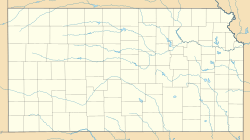Fort Aubrey facts for kids
Quick facts for kids |
|
|
Fort Aubrey Site
|
|
| Location | Near Sand Creek, east of Syracuse, Kansas |
|---|---|
| Area | 1 acre (0.40 ha) |
| Built | 1864 |
| NRHP reference No. | 78001281 |
| Added to NRHP | August 31, 1978 |
Fort Aubrey was an important military post in eastern Hamilton County, Kansas. The U.S. Army first set up a camp here in the 1850s. At first, it was just a temporary stop for soldiers and travelers. The fort was named after François Xavier Aubry, who suggested the location.
Contents
What Was Fort Aubrey?
Fort Aubrey was not always a permanent fort. For many years, it was just a camp that was used on and off. Soldiers would sometimes stay there to keep it ready for use. Other times, it was left empty.
Location and Purpose
The camp was built near a natural spring. This spring was about fifteen feet wide and three feet deep. It was located on Spring Creek, close to the Arkansas River. The camp was also right on the famous Santa Fe Trail. This made the spring a vital stop for soldiers, regular travelers, and Native American groups passing through the area.
Early Days and Naming
For a long time, the camp didn't have an official name. In May 1864, it was named Camp Wynkoop. This was to honor Major Edward W. Wynkoop, who was a commander at Fort Lyon. Around this time, a station for stagecoaches was also built at Camp Wynkoop. Even when the army left the camp in August, the stage station stayed open.
The area around the camp could be dangerous. There were conflicts with some Native American groups. At least once, four soldiers working near the camp were killed.
Becoming a Permanent Fort
Because of the increasing troubles in the area, the army decided to build a permanent fort. In August or September 1865, two companies of the 48th Wisconsin Infantry built Fort Aubrey. However, this permanent fort did not last long. It was closed on April 15, 1866.
Fort Aubrey Today
Even though Fort Aubrey was only used for a short time, its history is important. In 1978, the site of the fort was added to the National Register of Historic Places. This means it is recognized as a special historical place in the United States.



